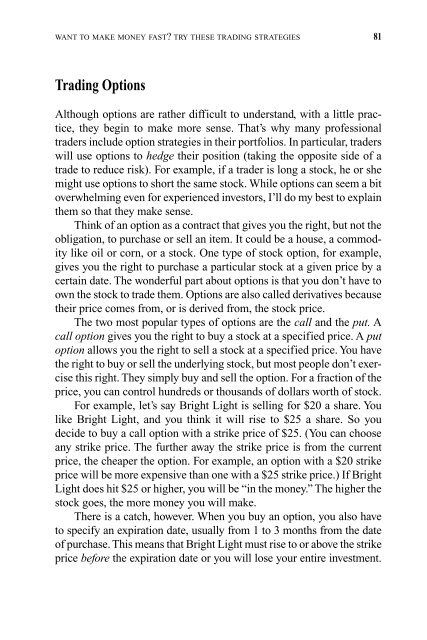Understanding Stocks
Understanding Stocks
Understanding Stocks
Create successful ePaper yourself
Turn your PDF publications into a flip-book with our unique Google optimized e-Paper software.
WANT TO MAKE MONEY FAST? TRY THESE TRADING STRATEGIES 81<br />
Trading Options<br />
Although options are rather difficult to understand, with a little practice,<br />
they begin to make more sense. That’s why many professional<br />
traders include option strategies in their portfolios. In particular, traders<br />
will use options to hedge their position (taking the opposite side of a<br />
trade to reduce risk). For example, if a trader is long a stock, he or she<br />
might use options to short the same stock. While options can seem a bit<br />
overwhelming even for experienced investors, I’ll do my best to explain<br />
them so that they make sense.<br />
Think of an option as a contract that gives you the right, but not the<br />
obligation, to purchase or sell an item. It could be a house, a commodity<br />
like oil or corn, or a stock. One type of stock option, for example,<br />
gives you the right to purchase a particular stock at a given price by a<br />
certain date. The wonderful part about options is that you don’t have to<br />
own the stock to trade them. Options are also called derivatives because<br />
their price comes from, or is derived from, the stock price.<br />
The two most popular types of options are the call and the put. A<br />
call option gives you the right to buy a stock at a specified price. A put<br />
option allows you the right to sell a stock at a specified price. You have<br />
the right to buy or sell the underlying stock, but most people don’t exercise<br />
this right. They simply buy and sell the option. For a fraction of the<br />
price, you can control hundreds or thousands of dollars worth of stock.<br />
For example, let’s say Bright Light is selling for $20 a share. You<br />
like Bright Light, and you think it will rise to $25 a share. So you<br />
decide to buy a call option with a strike price of $25. (You can choose<br />
any strike price. The further away the strike price is from the current<br />
price, the cheaper the option. For example, an option with a $20 strike<br />
price will be more expensive than one with a $25 strike price.) If Bright<br />
Light does hit $25 or higher, you will be “in the money.” The higher the<br />
stock goes, the more money you will make.<br />
There is a catch, however. When you buy an option, you also have<br />
to specify an expiration date, usually from 1 to 3 months from the date<br />
of purchase. This means that Bright Light must rise to or above the strike<br />
price before the expiration date or you will lose your entire investment.

















